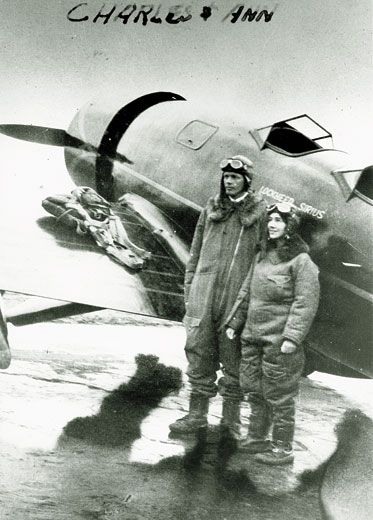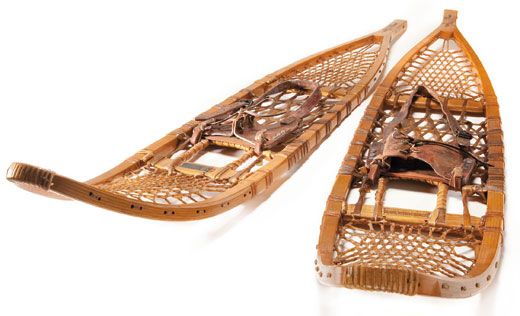In Case of Emergency, Pack Snowshoes
In 1933, Charles and Anne Morrow Lindbergh prepared for the worst by packing winter gear before flying over the Arctic
/https://tf-cmsv2-smithsonianmag-media.s3.amazonaws.com/filer/Object-at-Hand-snow-shoes-631.jpg)
in 1933, a young married couple packed for what the husband described as a vacation. The unlikely items they assembled included a sled, an inflatable rubber boat, enough food to last for several weeks and two pairs of snowshoes. On July 9—a little more than four years after their wedding—Charles and Anne Morrow Lindbergh took off from Long Island, New York, in a single-engine Lockheed Sirius aircraft to scout possible commercial air routes over the Arctic for Pan Am.
The Lindberghs were fleeing a tragedy that had riveted the world. Intense press attention had followed the kidnapping and death of their first child, 20-month-old Charles Jr., the year before. Departing for the Arctic, for all its potential perils, must have seemed a welcome escape.
Today, Charles’ snowshoes, displayed alongside the Lindberghs’ recently restored airplane and other items from that flight, are on view in the newly opened Barron Hilton Pioneers of Flight Gallery at the National Air and Space Museum (NASM).
The first legs of the Lindberghs’ journey, which charted a northern air route to Europe, took the couple north through Canada, then over Greenland and Iceland to the European continent, on a flight path that remains very close to what commercial jetliners use today. To describe the territory they flew over as hostile is to understate the hazards. The Sirius was equipped with pontoons should the couple have to touch down in the frigid North Atlantic. But a forced landing on Greenland’s glaciers meant they would have to walk to safety.
In an article she wrote for National Geographic after the trip, Anne would recall the hardships they had faced, vividly evoking conditions in an unheated cockpit over the North Atlantic: “I was wearing, in addition to woolen underwear, one thin wool shirt, one thick wool shirt, one wool sweater, wool riding trousers, several pairs of wool stockings, fur-lined...helmet, and over everything [a] hooded white blanket parka,” she wrote. “I was quite warm except for my feet, which I sat on, and my hands, on which I put another pair of mittens. A third pair would have been very comfortable, but would have made my fingers too bulky to handle the radio key.”
The Lindberghs, says NASM curator Dorothy Cochrane, “had to be prepared for everything, so they planned meticulously,” beginning with detailed lists compiled by Charles. In one volume of her memoirs, Listen! The Wind (1938), Anne recalled “those impressive itemized pages labeled ‘Airplane and Engine Equipment’...‘Emergency Equipment for Forced Landing at Sea,’ ‘Emergency Equipment for Forced Landing on Land,’ ‘Emergency Provisions.’” Time and again, she wrote, “I had seen the countless objects themselves, sorted out, appraised, and weighed, before the trip had begun.” Each item had to be scrupulously weighed because each cost its weight in fuel. A packet of 27 fishhooks, for instance, tipping the scales at barely an ounce, equaled precious seconds of flight time.
Author Reeve Lindbergh, at age 65 the youngest of Charles and Anne’s six children, recalls that “my father was an inveterate list maker.” So much so that “we made fun of him. He had a list for each of us kids, with entries like ‘rakes left out in the rain,’ and he would follow us around with them. But for him, lists were a part of self-preservation. He always talked about calculated, acceptable risk.”
Much of the gear for the 1933 flight acknowledged the possibility of a forced landing, reflecting his recognition of all the things that could go wrong during long hours in the air over trackless ice. So why did Lindbergh take his wife along on such a demanding journey?
“Charles could have had any co-pilot he wanted,” says Cochrane, who is working on a book focusing on the period when the Lindberghs flew together. “But he never really considered anyone else. He had taught Anne to fly, and they were still young marrieds. She worked hard to learn Morse code and navigation, and was a true co-pilot.”
“That was what their relationship was all about,“ Reeve says. “She wanted to be part of his world, and they continued to work together long afterward, even on her books.”
Owen Edwards in a freelance writer and author of the book Elegant Solutions.
/https://tf-cmsv2-smithsonianmag-media.s3.amazonaws.com/accounts/headshot/Owen-Edwards-240.jpg)


/https://tf-cmsv2-smithsonianmag-media.s3.amazonaws.com/accounts/headshot/Owen-Edwards-240.jpg)